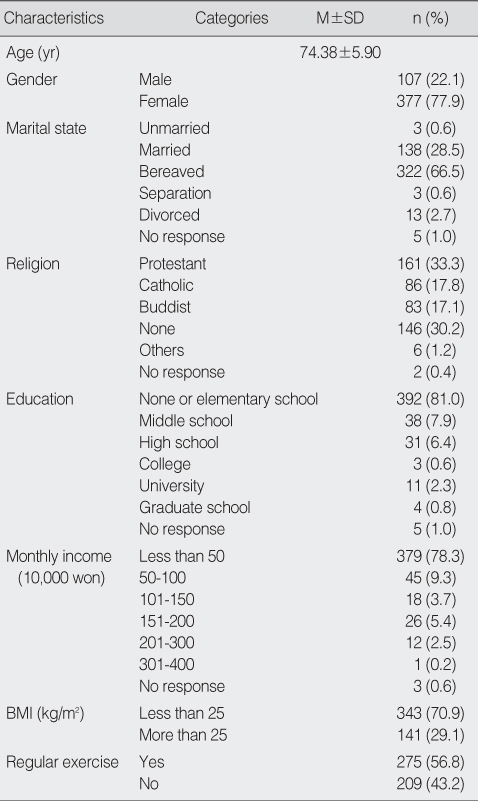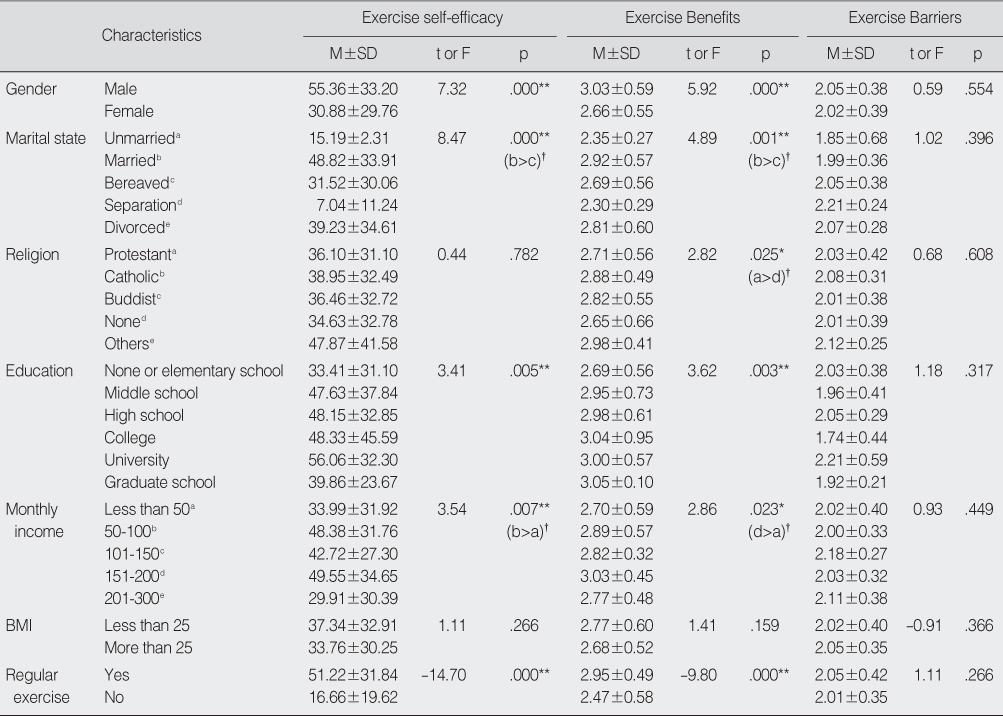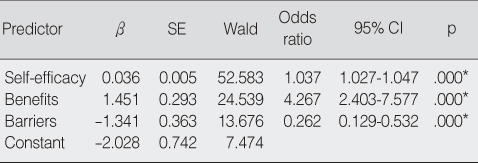Articles
- Page Path
- HOME > J Korean Acad Nurs > Volume 38(3); 2008 > Article
-
Original Article
- Effects of the Exercise Self-Efficacy and Exercise Benefits/Barriers on doing Regular Exercise of the Elderly
- Eun-Hee Hwang, Yeo-Sook Chung
-
Journal of Korean Academy of Nursing 2008;38(3):428-436.
DOI: https://doi.org/10.4040/jkan.2008.38.3.428
Published online: June 30, 2008
1Part-time Instructor, College of Nursing Science, Ewha Womans University, Seoul, Korea.
2Professor, College of Nursing, Margaret Pritchard University, Jeonju, Korea.
- Address reprint requests to: Hwang, Eun Hee. College of Nursing Science, Ewha Womans University, 11-1 Daehyeon-dong, Seodaemun-gu, Seoul 120-750, Korea. Tel: 82-2-3277-6693, Fax: 82-2-3277-4986, ehh0104@ewha.ac.kr
Copyright © 2008 Korean Society of Nursing Science
Abstract
-
Purpose
- The purpose of this study was to identify the effects of exercise self-efficacy and exercise benefits/barriers on doing regular exercise among elderly.
-
Methods
- The subjects were 484 older adults who were eligible and agreed to participate in this study. Data were collected from July 27 to September 21, 2007 by face-to-face, and private interviews. The questionnaires consisted of Exercise Self-efficacy, and Exercise Benefits/Barriers. The collected data were analyzed with the SPSS 13.0 program, which was used for frequency, percentage, mean, standard deviation, t-test, ANOVA, and logistic regression.
-
Results
- The major findings of this study were as follows: 1) Approximately 56.8% of participants were doing regular exercise. Study participants' exercise self-efficacy mean score was 36.30, exercise benefits 2.74, and exercise barriers 2.03; 2) There was significant correlation between exercise self-efficacy and exercise benefits; 3) Significant factors influencing regular exercise were self-efficacy, exercise benefits and exercise barriers.
-
Conclusion
- These results suggested that nurses should emphasize exercise benefits/barriers and reinforce self-efficacy to improve regular exercise in the elderly.
- 1. Bandura A. Self-efficacy: Toward a unifying theory behavioral change. Psychological Review. 1977;84:191–215.ArticlePubMed
- 2. Bandura A. Social foundations of thought and action: A social cognitive theory. 1986;Englewood Gliffs, New Jersey, Prentice Hall Inc..
- 3. Bandura A. Self-efficacy: The exercise of control. 1997;New York, Freeman & CO..
- 4. Byun HS, Kim KH. A study on the pain, perceived exercise barrier according to the general characteristics and exercise stage in the elderly with degenerative osteoarthritis. Journal of the Korean Gerontological Society. 2005;26:17–30.
- 5. Dergance JM, Calmbach WL, Dhanda R, Miles TP, Hazuda HP, Mouton CP. Barriers to and benefits of leisure time physical activity in the elderly: Differences across cultures. Journal of the American Geriatrics Society. 2003;51:863–868.ArticlePubMed
- 6. Frankel JE, Bean JF, Frontera WR. Exercise in the elderly: Research and clinical practice. Clinics in Geriatric Medicine. 2006;22:239–256.ArticlePubMed
- 7. Jang HJ, Shin YH. The cultural verification and psychometric evaluation of the exercise benefits/barriers scale for Korean adults with chronic disease. 1999;12;Seoul, Korea, Paper presented at the meeting of the 1st Asian-Pacific Nursing Congress Conference.
- 8. Jeong KH, Cho A, Oh YH, Byun YC, Byun JK, Mun HS. 1998 National wide survey about the actual living state and welfare need of the elderly. 1998;Seoul, Korea Institute for Health and Social Affairs.
- 9. Jung NH, Kim JM, Jeon HJ. Need and capacities to exercise for low-income elderly. Journal of the Korean Gerontological Society. 2006;26:895–910.
- 10. Kang SJ. The relationships among self efficacy, practice of self care and quality of life in patients with liver cirrhosis. 2003;Jinju, Gyeongsang National University. Unpublished master's thesis.
- 11. Kim HY. A study on the effects of health promoting behavior in elderly people on the satisfaction with life. 2005;Kimhae, Inje University. Unpublished master's thesis.
- 12. Kim K, Cho JK, Lee JC, Bae JJ, Park JY, Lee DH, et al. The effects of resistance exercise combined to muscle relax therapy in body composition and physical self-efficacy. Korea Sport Research. 2006;17:195–204.
- 13. 2005 Population and housing census. Korea National Statistical Office. 2006;Retrieved September 30, 2007. from http://www.nso.go.kr.
- 14. Landi F, Cesari M, Onder G, Lattanzio F, Gravina EM, Bernabei R. Physical activity and mortality in frail, community-living elderly patients. The Journal of Gerontology. 2004;59:833–837.
- 15. Lee PS, Chang SO, Park EY. Theme analysis related to performance of exercise in the elderly. Journal of Korean Academy of Psychiatric and Mental Health Nursing. 2001;10:484–495.ArticlePDF
- 16. Lee SH. Study on the meaning of perceived health and exercise of the elderly. 1996;Seoul, Hanyang University. Unpublished master's thesis.
- 17. Lee YM, Park HS. A study on the stage of change in exercise behaviors, exercise self efficacy, depression and stress in middle aged women. Korean Journal of Women's Health Nursing. 2004;10:218–225.ArticlePDF
- 18. McAuley E, Bane SM, Mihalko SL. Exercise in middle-aged adults: Self-efficacy and self-presentational outcomes. Preventive Medicine. 1995;24:319–328.Article
- 19. Morey MC, Pieper CF, Crowley GM, Sullivan RJ, Puglisi CM. Exercise adherence and 10-year mortality in chronically ill older adults. Journal of the American Geriatrics Society. 2002;50:1929–1933.Article
- 20. Park JM, Han SH. The effect of exercise program on health and depression in the elderly. Journal of Korean Academy of Nursing. 2003;32:220–227.
- 21. Park KO. A study on the health behavior and health status of the elderly living in Chung-Nam area. 2004;Daejeon, Daejeon University. Unpublished master's thesis.
- 22. Park RJ, Park HJ. Aged and exercise in view of exercise physiology. Journal of Korean Society of Physical Therapy. 2000;12:141–146.
- 23. Park YH, Kim JH, Kim HJ. Factors influencing regular exercise of the elderly. Journal of Korean Academy of Adult Nursing. 2002;14:348–358.
- 24. Pender NJ. Health promotion in nursing practice. 1996;3rd ed.Stanford, CT, Appleton & Lange.
- 25. Resnick B. A longitudinal analysis of efficacy expectations and exercise in older adults. Research and Theory for Nursing Practice. 2004;18:331–343.ArticlePubMed
- 26. Resnick B, Spellbring AM. Understanding what motivates older adults to exercise. Journal of Gerontological Nursing. 2000;26(3):34–42.Article
- 27. Sechrist KR, Walker SN, Pender NJ. Development and psychometric evaluation of the exercise benefits/barriers scale. Research in Nursing & Health. 1987;10:357–365.Article
- 28. Shin KR, Kim JS. The effects of exercise program on knowledge and attitude of exercse and depression in low-income elderly women. Journal of Korean Academy of Nursing. 2005;35:1144–1152.PubMed
- 29. Shin YH, Jang HJ. Perceived exercise self-efficacy and exercise benefits/barriers of Korean adults with chronic disease. Journal of Korean Academy of Nursing. 2000;30:869–879.
- 30. Shin YH, Jang HJ, Pender NJ. The psychometric evaluation of the exercise self-efficacy scale among Korean adults with chronic disease. Research in Nursing & Health. 2001;24:68–76.
REFERENCES
Figure & Data
REFERENCES
Citations

- Understanding regular exercise behavior in frail older adults: a structural equation model based on social-cognitive variables
Shiqi Yu, Jie Lin, Siping Song, Shuqi Huang, Fan Liu, Mingzhao Xiao
BMC Geriatrics.2025;[Epub] CrossRef - Beden, Zihin ve Toplum: Egzersiz Katılımcılarında Bedeni Beğenme, Sosyal Bağlılık ve Mutluluk İlişkisi
Feyza Meryem Kara, Rabia Dumay, Sümeyye Topçuoğlu, Serpil Evlice
Herkes için Spor ve Rekreasyon Dergisi.2024; 6(3): 272. CrossRef - Factors Influencing Performance of Exercise Behavior of Middle-Aged Men with Chronic Disease Based on the Information–Motivation–Behavioral Skill-Revealed-Related Variables (IMBR) Model
Hee-Kyung Kim, Hyoungtae Kim, Jeong-Hyo Seo
Healthcare.2022; 11(1): 100. CrossRef - Psychometric testing of the Maltese versions of the Exercise Benefits/Barriers Scale and Exercise Motivation Inventory – 2
Karl Spiteri, John Xerri de Caro, Kate Grafton, David Broom
Health Psychology Research.2022;[Epub] CrossRef - Exercising With Embodied Young Avatars: How Young vs. Older Avatars in Virtual Reality Affect Perceived Exertion and Physical Activity Among Male and Female Elderly Individuals
Jih-Hsuan Tammy Lin, Dai-Yun Wu
Frontiers in Psychology.2021;[Epub] CrossRef - Effects of Exercise Program for Women of Old-Old Age in Senior Citizen Halls based on Pender's Health Promotion Model
Kyoung Im Lee, Young Eun
Journal of muscle and joint health.2016; 23(2): 71. CrossRef - The Relationship between Health Belief and Exercise Compliance among Elderly Adults at Senior Centers
Kyung Im Lee, Young Eun
Journal of Korean Academy of Community Health Nursing.2015; 26(2): 79. CrossRef - The Effects of an Intervention on Physical Activity Among Nursing Home Residents in Wuhan, China
Xiu Xiu Liu, Jie Hu
Journal of Gerontological Nursing.2015; 41(3): 30. CrossRef - Association among ageing‐related stereotypic beliefs, self‐efficacy and health‐promoting behaviors in elderly Korean adults
Hyun‐E Yeom
Journal of Clinical Nursing.2014; 23(9-10): 1365. CrossRef - Construction of a Physical Activity Model for the Elderly
Nam-Hee Kim, Hyoung-Sook Park, Myunghan Choi
Korean Journal of Health Education and Promotion.2013; 30(1): 27. CrossRef - Factors Influencing Exercise Compliance among Older Adults
Young-Ji Ko, Ju-Hee Lee
Journal of muscle and joint health.2012; 19(2): 223. CrossRef - Korean Version of the Outcome Expectations for Exercise Scale-2: Validation Study
Mona Choi, Dukyoo Jung
Korean Journal of Adult Nursing.2012; 24(6): 580. CrossRef
General Characteristics of Study Participants (N=484)
BMI=Body Mass Index.
Description of Exercise-Related Characteristics (N=484)
Exercise-Related Characteristics by General Characteristics (N=484)
*p<.05; **p<.01; †Tukey. BMI=Body Mass Index.
Correlation between Exercise Self-efficacy, Benefits, and Barriers (N=484)
*p<.01.
Logistic Regression Analyses of Exercise (N=484)
*p<.01.
CI=Confidence Interval.
BMI=Body Mass Index.
*p<.05; **p<.01; †Tukey. BMI=Body Mass Index.
*p<.01.
*p<.01. CI=Confidence Interval.
 KSNS
KSNS
 E-SUBMISSION
E-SUBMISSION





 Cite
Cite

